Defining Luxury in Hospitality: Insights from CIUK Spring Networking with Nicolle Cairney
This spring, Commercial Interiors UK (CIUK), the trade association representing UK commercial interiors furnishing suppliers, held their Spring Networking event, which included a talk entitled ‘Defining Luxury,’ at the Clayton Hotel in Glasgow. This gathering, in partnership with Design Insider, offered a rich tapestry of opportunities for its members and the broader community of commercial interior designers to come together, share ideas, and forge new connections in a venue known for its style and sophistication.
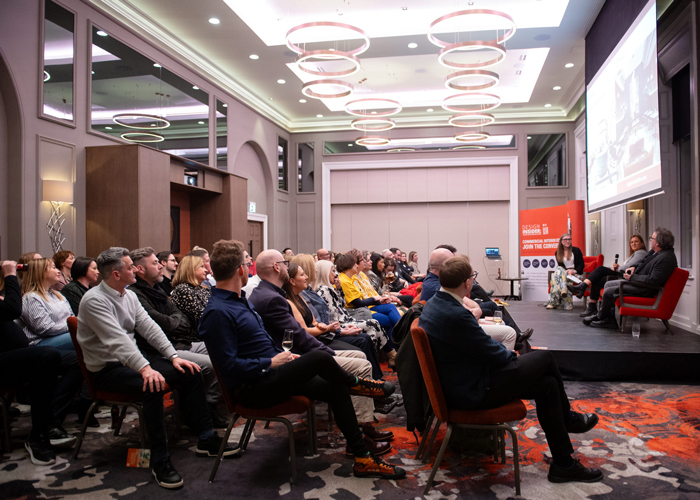
At CIUK Spring Networking event design professionals engage in rich discussions at Glasgow’s Clayton Hotel
At the heart of the event was a discussion led by Alys Bryan, Design Insider’s Managing Editor, who steered the conversation between Jim Hamilton of Graven and Nicolle Cairney from 3DReid. This conversation unravelled the multifaceted concept of luxury in today’s hospitality sector.
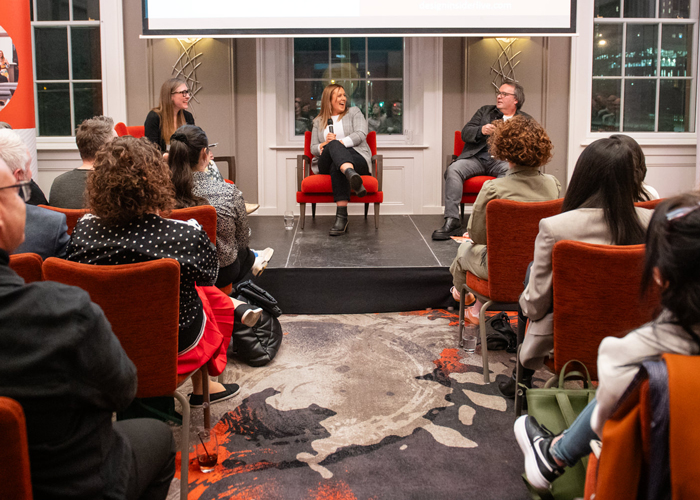
Nicolle Cairney discusses luxury’s evolving definition in hospitality at the CIUK and Design Insider event
Nicolle Cairney, with her extensive experience in hospitality design, notably her recent involvement with the AC Marriott in Glasgow, brought a unique blend of insight and passion to the discussion. Her expertise, particularly in historic restoration projects, added depth to the evening’s exploration of luxury.
Following this successful event, Design Insider took the opportunity to reconnect with Nicolle to recap on the knowledge she shared with the evening’s guests.

Nicolle Cairney takes the stage, ready to share her expert insights on luxury in hospitality design
“Luxury” is frequently used across various markets and product lines, how do you differentiate true luxury in hospitality? What criteria should be considered to genuinely classify a space or service as luxurious?
Luxury is often perceived as a buzzword that’s frequently used and can become diluted. It’s a term many aspire to be associated with, particularly in the context of brands and especially within the 4- and 5-star hotel sector.
By definition, luxury denotes a state of great comfort or elegance and is typically linked to a higher price point. When people think of luxury in hotels, they often imagine grand spaces adorned with exquisite finishes and elaborate chandeliers—this is the classic image that comes to mind.
However, the advent of social media has democratised these luxurious images, making them more accessible. Now, elements of what is traditionally considered luxury can be found in more budget-friendly markets through intelligent design and material choices.
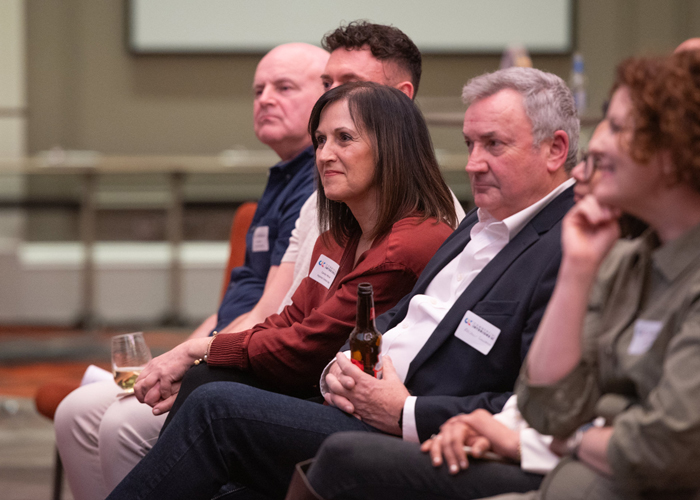
Attendees listen intently, captivated by the discussion’s blend of expert knowledge and engaging anecdotes on defining luxury
Our perceptions of luxury can also be influenced by our immediate experiences. For instance, enjoying a cup of hot tea and wrapping up in a warm blanket can feel luxurious after spending time in cold and wet conditions. Yet, in the context of hospitality, where guests are spending their hard-earned money, there is an expectation for more than just comfort. Guests seek an environment that offers opulence, style, and an enhancement to their life experience, defining luxury on a more personal and varied scale.
Location plays a crucial role in defining luxury, with proximity to attractions and transportation being significant factors. Luxurious hotels often stand out due to their seamless integration of architecture and interior design, coupled with meticulous attention to every detail, from soft furnishings and bespoke elements to carefully curated menu selections.
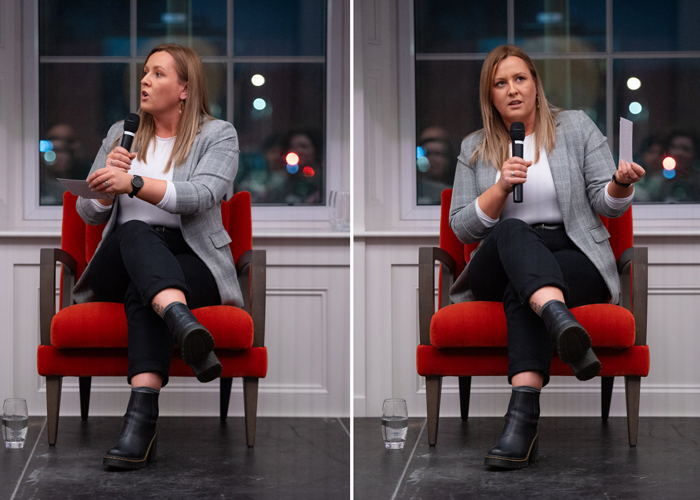
Nicolle explores how bespoke design enhances luxury in hospitality settings
Given the significant role of location in defining a hotel’s luxury status, how do you balance the intrinsic value of a prime location with the need to create an internally consistent luxury experience, ensuring that the design and services within the hotel complement its prestigious setting?
Privacy is another essential aspect of luxury. Many guests prioritise amenities like private pools and spa access. When designing hotels, it’s important to consider acoustic privacy to prevent noise transfer, ensuring guests don’t feel overlooked or disturbed by sounds like footsteps in the hallway or the noise of room cleaning, which can detract from the luxurious experience.
The level of service provided can greatly enhance the sense of luxury. This could include a chauffeur service from the airport, a warm towel or a cookie upon check-in, or the infusion of scents in spaces. In-room features also contribute significantly to luxury, such as high thread count linens, spacious bathrooms with underfloor heating, and thoughtfully designed cabinetry that includes amenities like mini-fridges, loose leaf teas, and cafetières, offering a more upscale experience than what’s typically found in budget accommodations.
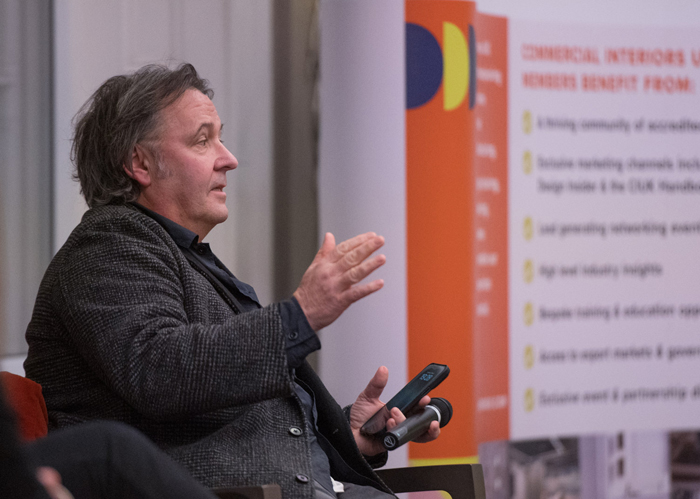
Jim Hamilton shares his expert perspective on luxury and design innovation in the hospitality industry
Furthermore, the availability of well-considered amenities for storing personal items, places for doing hair and makeup with appropriate lighting and outlets, and adaptable spaces in guest rooms to cater to various needs like working or relaxing, are all aspects that enhance the overall experience, distinguishing a luxurious stay from a more standard one.
Personalisation in hospitality is increasingly sought after, often associated with a higher cost. A prime example is The Ritz in Miami, which customises guest experiences based on the information provided during booking, catering even to specific needs like accommodations for a guest’s dog with personalised items such as a dog robe. This customisation underscores the value of exclusivity, where guests are willing to pay a premium for experiences that feel uniquely tailored to them.
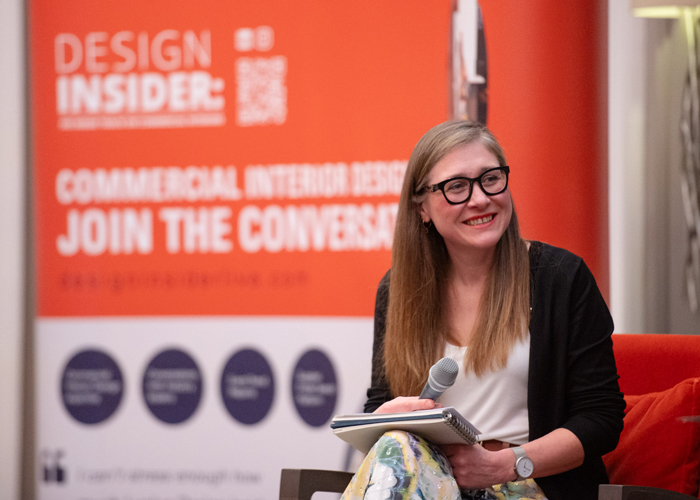
Alys Bryan moderates a deep dive into luxury hospitality design, guiding the event’s insightful discussions
Considering the emphasis on personalization in luxury hospitality, how do designers and hoteliers balance the desire for unique, tailored experiences with the need to maintain consistency and quality in service and design, ensuring that every guest’s personalized experience upholds the hotel’s luxury standards?
Boutique hotels illustrate this trend well. They are typically smaller, offering fewer rooms and amenities but compensating with unique design elements that reflect the local culture and additional personalised touches. These hotels offer a more intimate experience, often featuring unique attributes like rooftop gardens, enhancing the sense of exclusivity by providing access to amenities not commonly found elsewhere.
Inclusivity is equally crucial in defining luxury. It’s essential for luxury spaces to be accessible to all guests, including those with physical or neurodiverse conditions. Regardless of how aesthetically pleasing a space is, its value diminishes if it’s not accessible to everyone. Therefore, top hotels globally are prioritising inclusivity, ensuring that all guests, regardless of their physical abilities or conditions, can enjoy the luxury and comfort they offer.
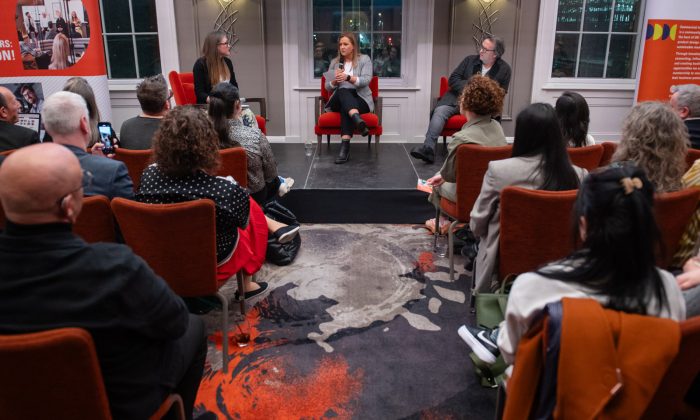
Nicolle highlights the integration of sustainability with luxury in hospitality design
Luxury can be perceived differently by various individuals, and typical designs may not always address everyone’s needs. Ensuring that we provide an equivalent level of environment and service to all guests is crucial. The Amilla Maldives hotel serves as an exemplary model in this regard. Despite its luxury, with beautifully designed rooms, private pools, and a variety of dining options, it stands out as the world’s first Accessibility and Inclusion Certified resort. The resort is designed to be fully accessible, featuring amenities like beach and floating wheelchairs and offering sensory experiences for guests with visual impairments or neurodiverse conditions, ensuring every guest receives equal care.
While not every project may reach such levels of inclusion, true luxury necessitates considering the experiences of all guests. A well-thought-out design, combining aesthetic beauty with functional considerations and exceptional service, enhances the overall experience, aligning more closely with true luxury.
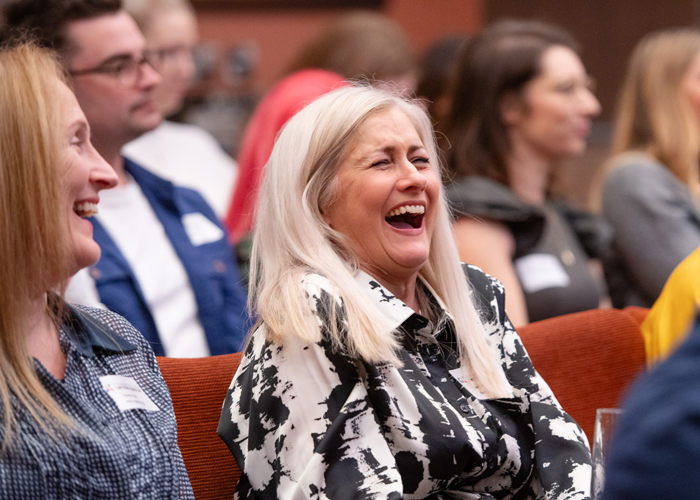
Laughter ripples through the audience, a testament to the speakers’ wit, making complex topics on luxury both enlightening and entertaining
The definition of luxury is constantly evolving, influenced by social media, trends, and personal experiences. For instance, caviar, once considered a common food, is now a symbol of luxury. This evolution underscores the need for the hospitality industry to remain adaptable and forward-thinking, ensuring that designs and services not only cater to current trends but also anticipate and adapt to changing perceptions of luxury.
Sustainability is increasingly becoming a priority in design but can often be seen as at odds with traditional luxury aesthetics. How can designers reconcile these aspects to create spaces that are both luxurious and sustainable? What materials or design practices can lead the way?
I agree that it can be seen at odds. Acknowledging the potential contrast between luxury and sustainability, it’s noteworthy that recent advancements in sustainable materials and products have significantly improved. Sustainable products no longer have to appear unfinished or less refined.
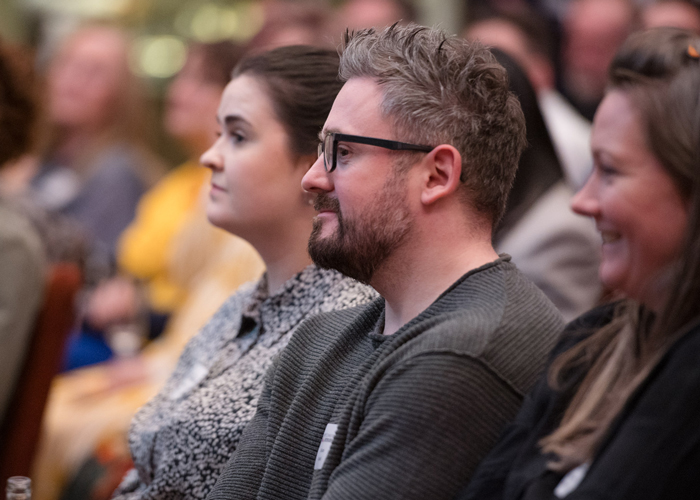
An engaged audience absorbs valuable insights, their expressions reflecting the depth of the conversation on luxury in hospitality design
Key to integrating sustainability is thorough research to verify the true eco-friendliness of products, avoiding any greenwashing tactics. This involves scrutinising the origins of recycled plastics to determine whether they contribute to solving pollution issues or merely cycle the same problem. Understanding the chemicals involved in manufacturing, the processes for applying finishes to products, the methods of dyeing, the implications of fire treatments on fabrics, and the overall carbon footprint of getting these products to their destination is essential.
Transparency from suppliers is critical. Reputable brands should provide detailed information about the sourcing, manufacturing, and end-of-life processes of their products. This might include data on where materials are sourced, how products are made, and their recyclability or disposal methods. Additionally, considering the lifecycle of samples, such as whether they can be returned or if binders and swatch books are recyclable, is another aspect of sustainable practice to consider.
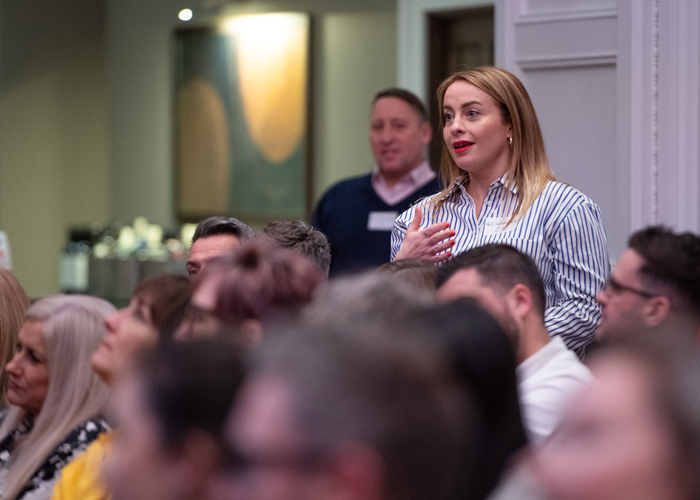
Audience members seize the opportunity to ask probing questions, deepening the dialogue on luxury in hospitality design
Eco-conscious travel is becoming increasingly popular, and for many in this market, luxury no longer equates to excess. Instead, mindful consumption is the goal, which extends beyond material finishes to include services. While designers may not have direct control over these aspects, there is a noticeable shift among some operators towards sustainable practices. For example, allowing guests to pre-select meals to minimise food waste and ensuring hotel restaurants order only what is necessary can enhance a brand’s unique selling proposition. As people become more engaged with sustainable practices, their interest in sustainable products grows.
With the rising trend of eco-conscious travel and the evolving expectations of luxury consumers, how are designers leveraging innovative sustainable practices and materials to not only meet but exceed the luxury standards of today’s environmentally aware guests?
Here are some notable sustainable materials and high-end products:
Diamik Glass: This is a sustainable alternative to traditionally mined surfaces like quartz or granite. It is customisable, which adds a personal touch. Notable uses include the Bombay Sapphire visitor centre and glass screens within the Fortnum and Mason chocolate department.
Tomas and Jani – Kava surfaces: These surfaces are plastic-free, made from coffee waste and organic fibres. They decompose naturally in landfills without releasing toxic ingredients, showcasing a commitment to environmental responsibility.
Faux planting: While trendy and beneficial for mental health, faux plants are typically made from plastics, which can emit harmful airborne chemicals and are challenging to recycle or repurpose. An alternative is Plant Designs’ real plants that are naturally preserved using an eco-friendly process. This process replaces the plant’s sap, ensuring the plants last for years without emitting harmful chemicals or needing water.

Experts Nicolle Cairney and Jim Hamilton discuss luxury’s nuances at the CIUK event
The Nationale Nederlanden Rotterdam office is an exemplar of 100% circular design, where every item in the existing building was catalogued and evaluated for potential reuse or repurposing. Innovative materials were incorporated, such as flax-based tiles for wall coverings, which boast aesthetics reminiscent of pinecones or bird feathers. Mycelium light fittings stand out as a key feature, alongside creatively reconfigured pieces of piping and old furniture transformed into pendant lights for meeting rooms. This project achieved the WELL V2 Platinum accreditation, and Pieter Lems’ TED Talk provides an insightful overview of the entire process.
Another noteworthy example is the QO hotel in Amsterdam, a 4-star establishment aligned with sustainable materials and practices under the Conscious Hotels brand. Their approach doesn’t compromise on aesthetics; the furniture and case goods are designed to serve multiple purposes, minimising the quantity needed without sacrificing functionality or style. This philosophy of ‘less is more’ allows for the inclusion of distinctive pieces that enhance the space’s overall appeal.
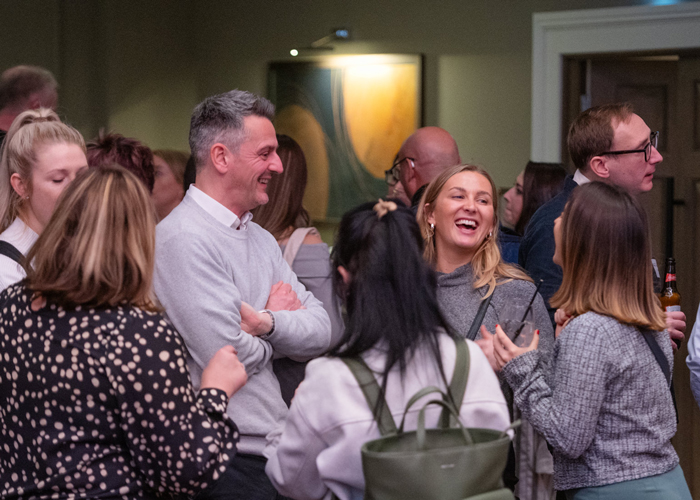
Interior designers and CIUK member suppliers network, sharing ideas and forging new connections at the Clayton Hotel in Glasgow
The question arises: Can virtual reality (VR) be leveraged to reduce waste associated with sample rooms? Additionally, how can we employ smarter strategies to anticipate and resolve potential site issues and clashes, thereby minimising unnecessary work and waste? These considerations are crucial for advancing sustainability in design and construction practices.
Bespoke design offers uniqueness and personalisation, but it also comes with higher costs and longer development times. How important is bespoke design in defining luxury in hospitality, and how do designers balance the desire for custom solutions with the practicalities of budget and timeline constraints?
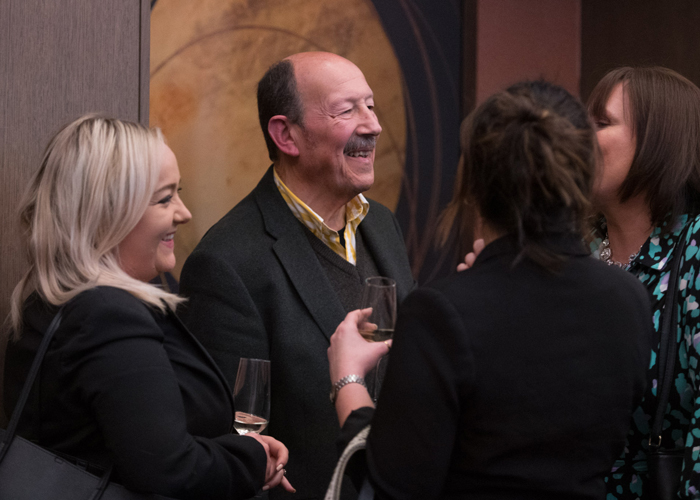
Members of Commercial Interiors UK and designers unite, exploring innovative solutions and partnerships in a sophisticated setting
In custom design, particularly within restoration projects, bespoke case goods are often crafted to fit specific spaces, reflecting a high degree of customisation. Bespoke solutions can sometimes be more time-efficient than off-the-shelf purchases, especially when navigating summer shutdowns and supply chain challenges. Moreover, bespoke items can offer better value and flexibility, allowing for adjustments that align with the desired aesthetics while ensuring practicality and functionality.
Utilising off-the-shelf components, such as table bases, combined with customised elements like Tomas and Jani or Diamik glass tabletops, can enhance design flexibility. An innovative approach might include repurposing waste materials from a site; for instance, a hotel lobby redesign in Skye involves restoring an antique table to serve as a base for a new, bespoke tabletop. This project also incorporates shells sourced from local fishermen, integrating them into the tabletop to create a distinctive look and contribute to the space’s narrative.
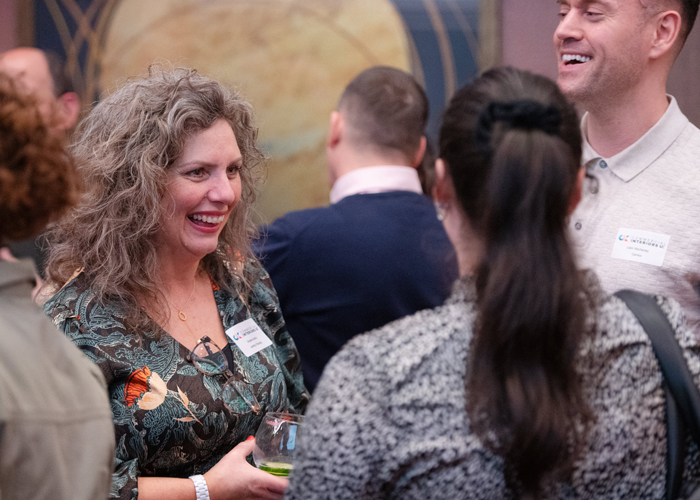
Attendees at the CIUK event engage in meaningful discussions, highlighting the collaboration between designers and suppliers
How do designers ensure that the bespoke elements not only contribute to the unique aesthetic of a space but also align with the overarching sustainability and durability goals, particularly in luxury hospitality environments where guest expectations are continually evolving?
When creating unique items for a venue, the longevity of the finished product is a key consideration. This encompasses not only the materials used but also the manufacturing process. Investing in high-quality manufacturing can reduce future waste, underscoring the importance of sustainability. Additionally, when employing standard products, it’s crucial to assess their suitability and potential need for adaptation, such as modifying upholstery to match the design scheme or the environmental context where the item will be placed.
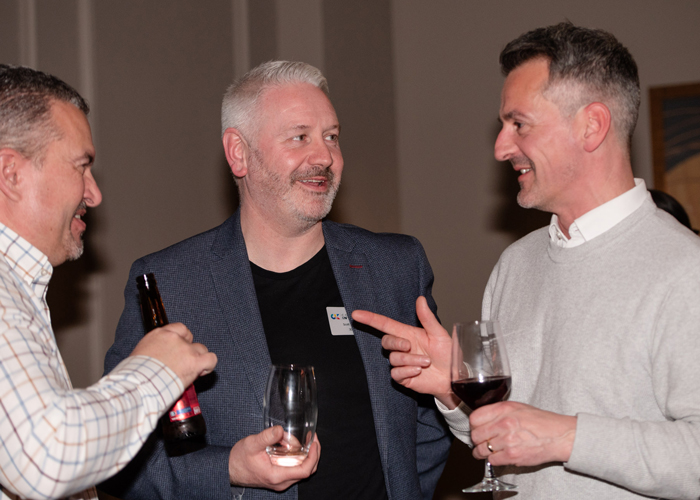
An evening of enjoyment and professional engagement, as CIUK members and designers mingle, fostering strong industry connections
Ultimately, while adhering to budgets and timeframes, designers must consider stock availability and lead times. Incorporating sustainability often means dealing with limited stock, as sustainable practices typically involve producing items based on demand rather than mass-producing for inventory. This approach might necessitate waiting for items that are not immediately available, even if they aren’t bespoke.
Developing a strong design concept early and securing prompt approval can be challenging but is crucial for allowing adequate time to procure or create bespoke pieces. This early planning and approval process helps in aligning design objectives with sustainability goals, ensuring that the end product is both aesthetically pleasing and environmentally conscious.
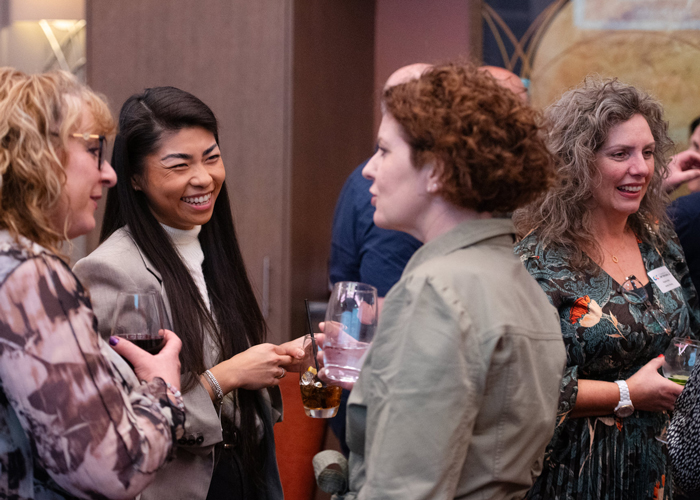
Designers and suppliers build lasting relationships over delightful food and drink, enhancing collaboration in a relaxed atmosphere
Did you miss Commercial Interiors UK Spring Networking event? Join us at their next event! Cardiff OPEN, Wednesday 19 Jun 2024 12:00 PM – 8:00 PM at Mercure Cardiff Holland House Hotel & Spa, CF24 0DD – Register your FREE ticket here
This pop-up exhibition will give interior designers, buyers, hoteliers and specifiers the opportunity to meet in person with some of the best contract furnishing suppliers from the UK. It will consist of established manufacturers and suppliers who will be highlighting their high-end products offering value, excellence & innovation to the Welsh market. Visitors will see a variety of products suitable for the full spectrum of interiors for Hospitality, Education, Restaurant, Healthcare, Cruise, and Workplace.
Design Insider will also host an engaging Design Insider Talks CPD Accredited programme at the event, welcoming leading interior design practices and suppliers onto the stage. These discussions will be moderated by Design Insider’s Editor, Alys Bryan, offering a unique opportunity to delve into the minds of those who shape our sector.




